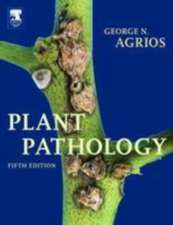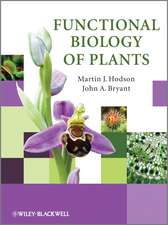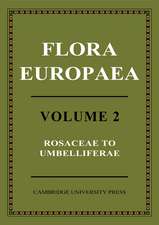Bacterial Wilt Disease: Molecular and Ecological Aspects
Editat de Philippe Prior, Caitilyn Allen, John Elphinstoneen Limba Engleză Paperback – 21 sep 2011
Bacterial wilt, caused by Ralstonia solanacearum, is a very destructive plant disease that attacks over 450 different species, including many of the most important economic crop plants. Often endemic, the bacterium transmits through the soil, penetrates the plant root system and eventually causes irreversible wilting and death. This book summarizes the current information on bacterial wilt for both the basic research community and for concerned professionals who are faced with the disease in the field, offering the latest approaches to diagnosis and control of the disease. Emphasis is placed on integrated and biologically sustainable control methods. Also presented is the most recent genetic/biochemical research exploring the interaction between the bacterium and its plant host at the molecular level.
| Toate formatele și edițiile | Preț | Express |
|---|---|---|
| Paperback (1) | 1049.38 lei 38-45 zile | |
| Springer Berlin, Heidelberg – 21 sep 2011 | 1049.38 lei 38-45 zile | |
| Hardback (1) | 1231.01 lei 6-8 săpt. | |
| Springer Berlin, Heidelberg – 17 mar 1998 | 1231.01 lei 6-8 săpt. |
Preț: 1049.38 lei
Preț vechi: 1380.76 lei
-24% Nou
Puncte Express: 1574
Preț estimativ în valută:
200.79€ • 209.65$ • 166.19£
200.79€ • 209.65$ • 166.19£
Carte tipărită la comandă
Livrare economică 31 martie-07 aprilie
Preluare comenzi: 021 569.72.76
Specificații
ISBN-13: 9783642083617
ISBN-10: 3642083617
Pagini: 464
Ilustrații: XIV, 449 p. 62 illus., 7 illus. in color.
Dimensiuni: 155 x 235 x 24 mm
Greutate: 0.64 kg
Ediția:Softcover reprint of the original 1st ed. 1998
Editura: Springer Berlin, Heidelberg
Colecția Springer
Locul publicării:Berlin, Heidelberg, Germany
ISBN-10: 3642083617
Pagini: 464
Ilustrații: XIV, 449 p. 62 illus., 7 illus. in color.
Dimensiuni: 155 x 235 x 24 mm
Greutate: 0.64 kg
Ediția:Softcover reprint of the original 1st ed. 1998
Editura: Springer Berlin, Heidelberg
Colecția Springer
Locul publicării:Berlin, Heidelberg, Germany
Public țintă
ResearchDescriere
Jointly published with INRA, Paris.
Bacterial wilt, caused by Ralstonia solanacearum, is a very destructive plant disease that attacks over 450 different species, including many of the most important economic crop plants. Often endemic, the bacterium transmits through the soil, penetrates the plant root system and eventually causes irreversible wilting and death. This book summarizes the current information on bacterial wilt for both the basic research community and for concerned professionals who are faced with the disease in the field, offering the latest approaches to diagnosis and control of the disease. Emphasis is placed on integrated and biologically sustainable control methods. Also presented is the most recent genetic/biochemical research exploring the interaction between the bacterium and its plant host at the molecular level.
Bacterial wilt, caused by Ralstonia solanacearum, is a very destructive plant disease that attacks over 450 different species, including many of the most important economic crop plants. Often endemic, the bacterium transmits through the soil, penetrates the plant root system and eventually causes irreversible wilting and death. This book summarizes the current information on bacterial wilt for both the basic research community and for concerned professionals who are faced with the disease in the field, offering the latest approaches to diagnosis and control of the disease. Emphasis is placed on integrated and biologically sustainable control methods. Also presented is the most recent genetic/biochemical research exploring the interaction between the bacterium and its plant host at the molecular level.
Cuprins
One Hundred and One Years of Research on Bacterial Wilt.- Bacterial Wilt: the Missing Element in International Banana Improvement Programs.- Chair’s Perspective: Diversity of Ralstonia solanacearum.- Phylogeny, Diversity and Molecular Diagnostics of Ralstonia solanacearum.- Development of a Diagnostic Test Based on the Polymerase Chain Reaction (PCR) to Identify Strains of R. solanacearum Exhibiting the Biovar 2 Genotype.- Genetic Diversity of Ralstonia solanacearum Race 3 in Western Europe determined by AFLP, RC-PFGE and Rep-PCR.- Biogeographic Studies on Ralstonia solanacearum Race 1 and 3 by Genomic Fingerprinting.- Analysis of Genetic Variation of a Population of Banana Infecting Strains of Ralstonia solanacearum.- Genetic Diversity of Ralstonia solanacearum in Japan.- Diversity of Ralstonia solanacearum in Tomato Rhizosphere Soil.- Population Structure of Ralstonia solanacearum From a Disease Nursery and Tomato Production Fields in Taiwan.- Correlation of Aggressiveness with Genomic Variation in Ralstonia solanacearum Race.- Chair’s Perspective:.- Molecular Methods for Detection and Discrimination of Ralstonia solanacearum.- Adaptation of Technology for Diagnosis and Detection ofRalstonia solanacearum in Malawi and Tanzania.- Efficiency of a Vacuum Infiltration Inoculation Procedure for Detecting Ralstonia solanacearum in Soil.- Developing Appropriate Detection Methods for Developing Countries.- Evaluation of Methods for Detection of Potato Seed Contamination by Ralstonia solanacearum.- Detection of Ralstonia solanacearum in Potato Tubers, Solanum dulcamara and Associated Irrigation Water.- Selection of Ralstonia solanacearum Race 3 Specific Monoclonal Antibodies from Combinatorial Libraries.- Experiences with Bacterial Brown Rot Ralstonia solanacearum Biovar 2, Race 3 in the Netherlands.- Directions for Future Research on Bacterial Pathogenicity.- Analysis of Extracellular Polysaccharide I In Culture and In Planta Using Immunological Methods: New Insights and Implications.- Regulation of Virulence by Endogenous Signal Molecules and the Importance of Extracellular Polysaccharide During Infection and Colonization.- Function and Regulation of Pectin-Degrading Enzymes in Bacterial Wilt Disease.- The Ralstonia solanacearum hrp Gene Region: Role of the Encoded Proteins in Interactions with Plants and Regulation of Gene Expression.- Relationship of Wild Type Strain Motility and Interaction with Host Plants in Ralstonia solanacearum.- Studies on the Molecular Basis for Pathogenicity and Host Specificity in Strains of Ralstonia solanacearum Pathogenic to Banana.- Chair’s Perspective: Host Resistance.- Transcriptional Regulation and Function of hsr203J, an Hypersensitivity-Related Gene of Tobacco Activated in Respons to Ralstonia solanacearum.- An Anti-Ralstonia solanacearum Protein from Potato and Its Immunogold Localization In Vivo.- Involvement of Nitric Oxide in Ralstonia solanacearum-Induced Hypersensitive Reaction in Tobacco.- Correlation of Chemical Profiles of Xylem Fluid of Tomato to Resistance to Bacterial Wilt.- Behavior of Bioluminescent Ralstonia solanacearum YN5 Containing the luxCDABE in Tomatoes Susceptible and Resistant to Bacterial Wilt.- Genetic Analysis of Quantitative Resistance Loci (QRL) of Tomato Variety Hawaii 7996 in Taiwan.- Identification and Mapping of RRS1, a Single Recessive Locus in Arabidopsis thaliana that Confers Resistance to Ralstonia solanacearum.- Mi Introgression Lines as Tools for the Genetic Analysis of Bacterial Wilt Resistance in Tomato.- Genetics of Plant Resistance to Bacterial Wilt: Round Table Report.- Worldwide Evaluation of an International Set of Resistance Sources to Bacterial Wilt in Tomato.- Selection of Processing Tomato Progenies for Resistance to Ralstonia solanacearum.- Resistance Sources to Bacterial Wilt in Eggplant (Solanum melongena).- Breeding for Resistance to Bacterial Wilt of Potatoes in Brazil.- Relationship Between Latent Infection and Groundnut Bacterial Wilt Resistance.- Inheritance of Resistance to Bacterial Wilt in Chinese Dragon Groundnuts.- Resistance to Bacterial Wilt in Uganda.- Multiplication of Ralstonia solanacearum in Capsicum annuum.- Solanum tuberosum — S. commersonii Somatic Hybrids are Resistant to Brown Rot Caused by Ralstonia solanacearum.- Chairs’ Perspectives on Biological Control and Epidemiology.- The Suppression of Ralstonia by Marigolds solanacearum.- Elements of Biocontrol of Tomato Bacterial Wilt solanacearum.- The Development of a Biological Control Agent against Ralstonia solanacearum Race 3 in Kenya.- A Tentative Explanation of the Distribution, on Reunion Island, of Bacterial Wilt Caused by Either Biovar 2 or Biovar 3 of Ralstonia solanacearum.- The Effect of Temperature, Storage Period and Inoculum Concentration on Symptom Development and Survival of Ralstonia solanacearum in Inoculated Tubers.- Epidemiology of Tomato Bacterial Wilt in Agreste Region of Pernambuco State, Brazil, in 1996/1997.- Current Situation of Bacterial Wilt (Ralstonia solanacearum Smith) in Cuba.- Factors Affecting the Population of Ralstonia solanacearum in a Naturally Infested Field Planted to Tobacco.- Disease Management Session Commentary.- The Usefulness of Potato Resistance to Ralstonia solanacearum, for the Integrated Control of Bacterial Wilt.- Bacterial Wilt in Brazil: Current Status and Control Methods.- Disease Management Strategies for Control of Bacterial Wilt of Tobacco in the Southeastern USA.- Relative Importance of Latent Tuber Infection and Soil Infestation by Ralstonia solanacearum on the Incidence of Bacterial Wilt of Potato.- Maintaining Scottish Seed Potato Production Free From Ralstonia solanacearum.- Weeds as Latent Hosts of Ralstonia solanacearum in Highland Uganda: Implications to Development of an Integrated Control Package for Bacterial Wilt.- Round Table on Bacterial Wilt (Brown Rot) of Potato.- List of Authors.
Caracteristici
A review on the bacterium Ralstonia solanacearum, the cause of one of the most destructive diseases of crop plants








